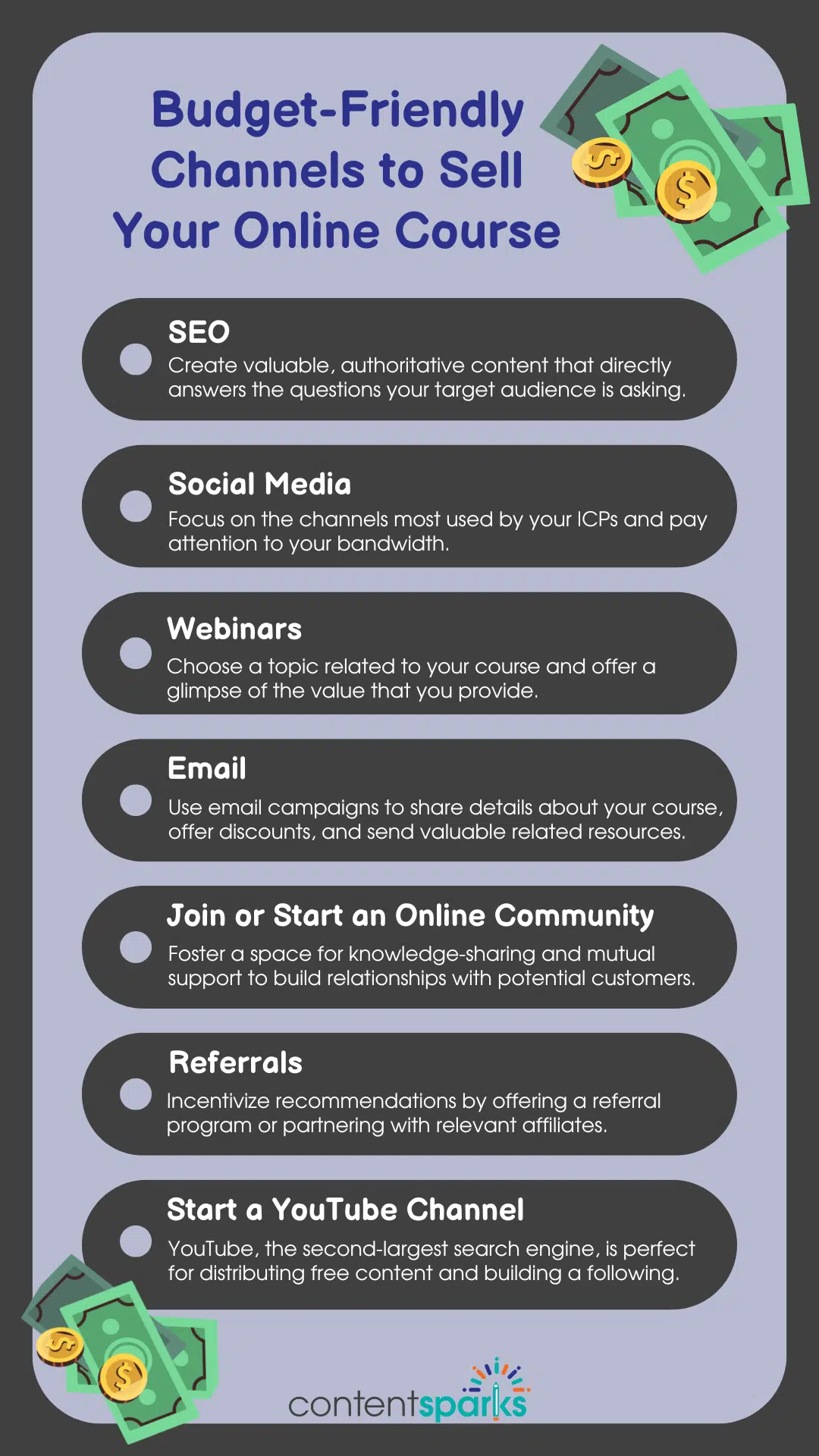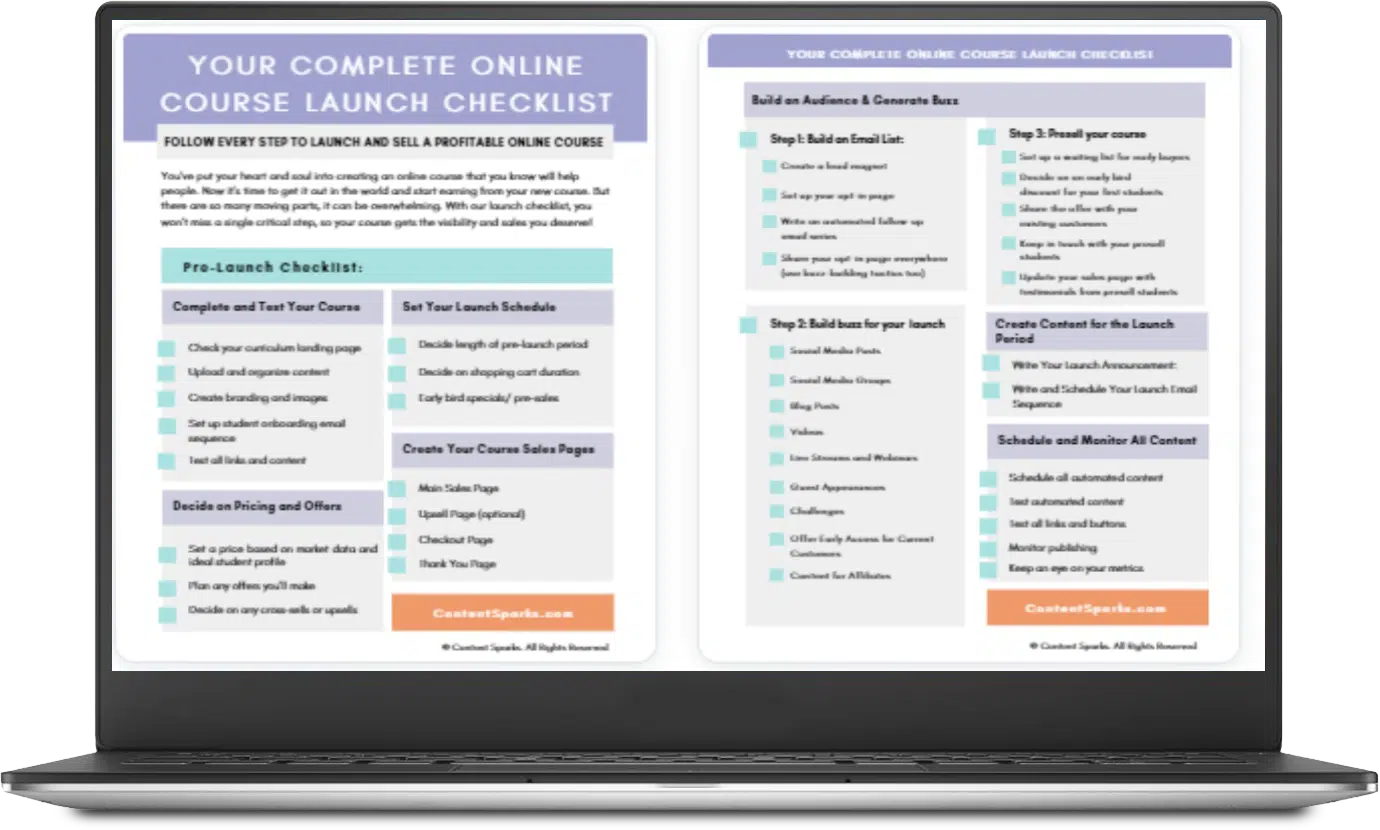A Budget-Friendly Approach to Marketing Your Online Course
0 comments
0 comments
You’ve spent months (or longer) pouring your heart and soul into creating an online course you know is top-notch.
The content is engaging, your expertise comes across brilliantly, and you’re confident the course can help people achieve real results. But here’s the rub: You don’t have an unlimited marketing budget to get the word out.
Sound familiar?
If you’re a coach, consultant, or small agency owner, you’re not alone. The good news is that you don’t need deep pockets to market your course effectively. In fact, some of the most powerful strategies are cost-effective and designed to maximize every dollar you spend.
In this article, we’ll dive into smart, budget-friendly marketing tactics that deliver serious impact.
“Winging it” won’t work.
An effective marketing strategy starts with a clear understanding of key fundamentals: the specifics of your course offerings, a unique and compelling value proposition, and a well-defined profile of your ideal customers.
Let’s tackle each piece one at a time:
If you want to dig deeper on this, read my article on how course creators can create their ICP as part of their online course launch checklist.
Next, we’ll dig into the Rule of Seven, a fundamental marketing principle that helps businesses of all shapes and sizes engage with their ICPs through thoughtful, targeted outreach.
The Rule of Seven is a marketing principle that’s been around since the 1930s, when movie studios noticed people needed to see ads about seven times before deciding to go to the theater. This idea took off back then and continues to guide how brands connect with audiences today.
That said, you don’t necessarily need to have a presence across seven totally different channels. The key is to establish relevant touchpoints aligned to your ICP, ensuring they occur consistently and often.
So, where do these touchpoints happen?
Your website is your business’s digital storefront and, at minimum, should contain relevant information about your course offerings, how to make a purchase or enroll, and get in touch with you. Social media platforms and email distribution services can help deliver content straight to your key audiences and support you with community building and sharing your course’s UVP.
This is just the beginning. In the next section, we’ll explore some budget-friendly strategies that expand on this even further and take your marketing game to the next level.

Now on to the good stuff – those course marketing channels that won’t break the bank (in fact, hopefully they’ll fill it).
You have an array of opportunities to build a cost-effective marketing strategy. These include:
The beauty of these budget-friendly channels is that they don’t require a hefty investment but can still deliver impressive results if executed properly. Let’s examine each one more closely.

The Ultimate Online Course Launch Checklist
Use this checklist to take action with your online course today!
Investing in SEO can lead to sustained website traffic and brand visibility. Your potential customers are likely already searching on Google for solutions to the problems your course addresses. To tap into this demand, focus on optimizing your website for search engines.
Create valuable, authoritative content that directly answers the questions your target audience is asking. Organize this content into topic clusters to improve both user experience and your site's authority in the eyes of search engines.
Don’t neglect technical SEO, either: Ensure your site loads quickly and that Google can easily index your content. For more information, review my complete guide to using SEO to promote your online course.
Social media has always been a go-to tool for building personal connections with your audience and generating word-of-mouth marketing, which is key for establishing credibility and trust. That said, be careful not to over-index on platforms. Focus on the channels most used by your ICPs and pay attention to your bandwidth.
Consistently post on your chosen platform and engage with your followers to grow your audience over time. Make sure your social media profiles reflect your expertise, and update your bios to include your course. Add direct links to your course or website to guide interested users.
Think creatively about content and engagement opportunities as well. For instance, hosting an AMA (ask-me-anything) on platforms like Reddit or Instagram can lead to direct interaction with prospects, showcase your knowledge, build trust, and drive up course sign-ups. Be sure to promote the AMA ahead of time to maximize participation.
Webinars offer a glimpse of the value that you provide and give you a way to attract, educate, and convert new leads. Think of a webinar as an hour (or whatever amount of time) worth of free consulting. Choose a topic related to your course.
Direct people to register for the webinar to receive your exclusive insights. During the webinar, pitch your course as the complete solution to the discussion topic. If you don’t have time to set up a webinar by yourself, try to join one as a guest or invite a collaborator to split the workload.
If you have an email list for your business, even a small one, it's still a proven tool for promoting your course. According to the marketing powerhouse OptInMonster, 59% of consumers say marketing emails influence their purchase decisions. As such, you can use email campaigns to share details about your course, offer discounts or special rates, and send valuable resources related to your course topic.
By consistently delivering value to your subscribers, you'll build trust and credibility, leading to more enrollments over time. Plus, your email list will remain a valuable asset for ongoing promotions, allowing you to continue driving interest in your course long after it launches.
For a detailed breakdown, check out my guide on the key emails to send when launching your course.
Online communities can be your highest-impact way to promote your course and establish your subject matter expertise - especially when the market is flooded with impersonal AI-generated courses. Whether you create a group on Facebook, LinkedIn, Slack, Discord, or another digital venue, these platforms allow you to gather like-minded people (ideally, your ICP) who share an interest in your course topic.
By fostering a space for knowledge-sharing and mutual support, you can build strong relationships with potential customers. As you engage in these communities, you can subtly promote your course, offer exclusive discounts, and provide relevant resources.
Even if you can't directly market your course in certain groups, your active participation and valuable contributions will naturally lead people to check out who you are and find your business and course offerings.
A customer base can mean a base of loyal followers. These people are your greatest assets, as their trust in your brand makes them natural ambassadors who can help spread the word about your course within their networks.
You can incentivize recommendations by offering a referral program or partnering with affiliates who have a similar audience. This multiplies your reach and helps generate more enrollments, ultimately creating a snowball effect of organic growth.
Additionally, try connecting with expert influencers in your niche. Many may be willing to review your course for free, giving you valuable social proof before your official launch.
YouTube, the second-largest search engine, is perfect for distributing free content and building a following for your course. If you're comfortable on video, YouTube can also be a monetization channel, allowing you to earn from ads as your audience grows.
For a more interactive connection, try livestreaming on social media platforms like Facebook, Instagram, LinkedIn, and YouTube. Hosting live sessions on specific topics related to your course can deepen engagement with audiences and even extend your reach across different online communities.
These channels on their own are great, but when you combine them and repackage content, something magical happens. Read on as I share how to amplify each of these channels by teaming them up.

The Ultimate Online Course Launch Checklist
Use this checklist to take action with your online course today!
Imagine you have a bushel of apples. While great on their own, they can easily be transformed into apple pie with some extra time and minimal resources.
The same concept applies to content. You don’t always need to create new material. Get creative about repurposing what you already have to maximize its value.
According to a ReferralRock survey, 94% of marketers are already repurposing content, underscoring its importance in modern marketing strategies. In a recent SEMrush content marketing study, 42% of marketers reported that repurposing existing content led to successful campaigns by boosting engagement and improving SEO.
So, how do you do this?
Think of how you might take a podcast interview you’ve done and break it down into smaller, bite-sized clips to share across your social media channels. You could also turn a blog post into an email series or use a powerful testimonial in your next pitch.
The key is to take your existing content and adapt it into different formats that reach your audience through various touchpoints. Repurposing content can save time and effort, and ensure every piece works harder for your business.
There’s one fatal flaw many new marketers fall victim to: they forget to track their campaigns.
When every dollar counts, it’s all the more reason to know and track your numbers to know what’s working for your marketing strategy. Reviewing your progress keeps you accountable and motivated. Plus, it’s a great way to uncover fresh content ideas or new ways to connect with prospects. Even small, data-based adjustments can lead to big improvements over time.
You don’t need fancy tools to get started. Here are some free and basic tools to help you get started:
If you’re stumped on what metrics to focus on, here’s what I’d recommend:
This is a bird's-eye view of the metrics you may want to track. For a deeper dive, check out our tailor-made guide on key marketing metrics every business should track.
Marketing your online course on a budget doesn’t mean you have to compromise on impact.
By leveraging cost-effective strategies, you can connect with your ideal customers and drive conversions without draining resources.
Ready to take the next step?
Click the button below to download my Complete Online Course Launch Checklist. This downloadable resource lays out clear action steps to help you go from concept to launch with confidence, ensuring you hit every key milestone along the way.
Tags